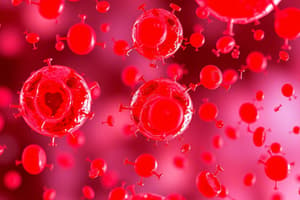Podcast
Questions and Answers
What does the prothrombin time (PT) assess?
What does the prothrombin time (PT) assess?
- Extrinsic pathway (correct)
- Presence of inhibitors
- Clotting factor deficiencies
- Intrinsic pathway
What does a prolonged activated partial thromboplastin time (APTT) indicate?
What does a prolonged activated partial thromboplastin time (APTT) indicate?
- Deficiency of extrinsic pathway factors
- Presence of thrombin
- deficiency of intrinsic pathway factors (correct)
- Deficiency of platelets
What does a mixing test with normal plasma differentiate?
What does a mixing test with normal plasma differentiate?
- Between hemophilia A and B
- Between thrombus and embolism
- Between arterial and venous bleeding
- Between coagulation factor deficiency and inhibitor presence (correct)
Which of the following may present with a normal APTT?
Which of the following may present with a normal APTT?
Which factors are involved in the final common pathway of coagulation?
Which factors are involved in the final common pathway of coagulation?
What can cause delay in clotting as measured in coagulation tests?
What can cause delay in clotting as measured in coagulation tests?
Heparin is classified as what type of coagulation factor issue?
Heparin is classified as what type of coagulation factor issue?
What is assessed to check for defects in the extrinsic and intrinsic pathways of coagulation?
What is assessed to check for defects in the extrinsic and intrinsic pathways of coagulation?
Which test would be performed if both PT and APTT are prolonged?
Which test would be performed if both PT and APTT are prolonged?
What type of blood cell abnormality is characterized by the presence of Howell-Jolly bodies?
What type of blood cell abnormality is characterized by the presence of Howell-Jolly bodies?
Flashcards are hidden until you start studying
Study Notes
Types of Anemia
- Iron Deficiency Anemia: Caused by excessive iron loss; women, especially, are at higher risk due to menstrual bleeding and pregnancy.
- Megaloblastic Anemia: Results from inadequate vitamin B12 and folic acid intake; leads to abnormal RBC production in the red bone marrow, often exacerbated by cancer medications.
- Pernicious Anemia: Occurs due to the stomach's failure to absorb vitamin B12, affecting absorption in the small intestine.
- Hemorrhagic Anemia: Characterized by significant red blood cell loss due to bleeding from sources like ulcers or menstruation.
- Hemolytic Anemia: Results from the rupture of RBC membranes, potentially due to parasites, toxins, or autoimmune responses.
- Thalassemia: Associated with diminished hemoglobin synthesis; prevalent in Mediterranean populations.
- Sickle Cell Anemia: A hereditary condition resulting in RBCs shaped like rigid sickles, causing various complications.
- Aplastic Anemia: Stemmed from the destruction of red bone marrow, often triggered by toxins or radiation.
Thrombotic Disorders
- D-dimer levels are assessed to exclude active thrombosis, particularly useful in diagnosing venous thromboembolism.
- Various tests identify underlying thrombosis risk factors, which may influence anticoagulation strategies; common examples include antiphospholipid antibody testing.
- Anticoagulants like warfarin and heparin can impact specific coagulation assays.
Motor Neurons
- Alpha Motor Neurons: Large neurons responsible for innervating extrafusal striated muscle fibers, key for voluntary movements.
- Gamma Motor Neurons: Smaller neurons that target specialized intrafusal muscle fibers, integral to the spindle stretch receptor.
- Beta Motor Neurons: Innervate both extrafusal and intrafusal muscle fibers.
Presenting Problems in Blood Disease
- Anemia: Defined by low hemoglobin levels; it can arise from varied causes, including dietary deficiencies and chronic diseases; rapid onset leads to pronounced symptoms.
- Iron deficiency anemia is the most common globally, especially prevalent due to blood loss or menstrual issues in women; detailed dietary assessments are vital for diagnosis.
Clinical Assessment and Investigation of Coagulation
- Causes of Anemia:
- Decreased or ineffective marrow production: Lack of iron, vitamin B12, or folate; malignant invasion; renal failure; anemia due to chronic disease.
- Peripheral causes: Blood loss, hemolysis, and hypersplenism.
Bleeding Disorders and Coagulation Tests
- Screening for bleeding disorders involves specific tests to evaluate clotting pathways, comparing with normal controls.
- Extrinsic Pathway: Evaluated using prothrombin time (PT).
- Intrinsic Pathway: Assessed using activated partial thromboplastin time (APTT).
- Coagulation is delayed with deficiencies or inhibitors (like heparin); prolongation of both PT and APTT suggests inhibition within the final common pathway or a general coagulation factor deficiency.
- A mixing test distinguishes between factor deficiencies and inhibitors; von Willebrand disease may show normal APTT.
Laboratory Indicators of Anemia
- Microcytosis: Small RBCs indicative of iron deficiency.
- Macrocytosis: Large RBCs often related to vitamin B12 or folate deficiency.
- Target Cells: Indicative of specific types of anemia.
- Spherocytes and Red Cell Fragments: Associated with hemolytic anemia.
- Nucleated RBCs and Howell-Jolly Bodies: Reflect underlying hematological conditions.
- Polychromasia and Basophilic Stippling: Markers for varying forms of anemia and cellular responses.
Studying That Suits You
Use AI to generate personalized quizzes and flashcards to suit your learning preferences.




